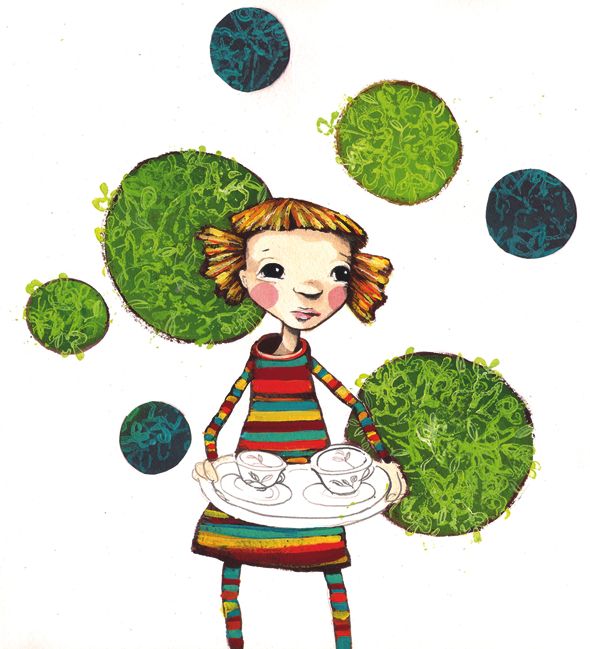Once upon a time…
13 January 2012 | Articles, Non-fiction

Sari Airola's illustration in Silva och teservisen som fick fötter (‘Silva and the tea set that took to its feet’, Schildts) by Sanna Tahvanainen
The future of book publishing is not easy to predict. Books for children and young people are still produced in large quantities, and there’s no shortage of quality, either. But will the books find their readers? Päivi Heikkilä-Halttunen takes a look at the trends of 2011, while in the review section we’ve picked out a selection of last year’s best titles
The supply of titles for children and young adults is greater than ever, but the attention the Finnish print media pays to them continues to diminish. Writing about this genre appears increasingly ghettoised, featuring only in specialist publications or internet chat rooms and blogs.
Yet, defying the prospect of a recession, Suomen lastenkirjakauppa, a bookshop specialising in children’s literature, was re-established in central Helsinki in autumn 2011, following a ten-year break. Pro lastenkirjallisuus – Pro barnlitteraturen ry, the Finnish society for the promotion of children’s literature, has been making efforts to found a Helsinki centre dedicated to writing and illustration for children. The society made progress in this ambition when it organised a pilot event in May 2011.
The Finnish publishing sector is undergoing changes, which also have an impact on books for children and young adults – even though such developments are not trumpeted. The number of small independents and self-publishers continues to grow. At their best, their products do not necessarily lag behind those of the big publishing houses. Even so, the professional editorial skills and long-standing expertise of the major publishers are reflected in quality as well as in the level of investment, both of which are increasingly consistent. But smaller publishers, too, reap fame and fortune through prizes and nominations. Karisto was particularly successful in 2011; over the last few years, it has invested in domestic books for children and young adults with renewed enthusiasm.
It remains to be seen how the recent merger of the two Finland-Swedish publishers, Schildts and Söderströms, will affect the amount of Finnish-Swedish children’s literature that is published. This language area has seen the emergence of many new and distinctive authors of picture books in particular.
The serial format has been on the increase since 2000, but it may soon be on the wane; authors themselves are already publicly and extensively questioning the excessive concentration on series. Domestic writing continues to reflect the popularity of fantasy, while authors are fortunately displaying growing willingness to replace international narrative patterns with variations on home-grown Finnish folklore. For example, Ritva Toivola makes use of ghost stories and folk tales in her historical novel for young adults, Anni unennäkijä (‘Anni the dreamer’, Tammi). In her collection of tales, Lymyvuoren peikot, (‘The trolls of Skulk Mountain’, Tammi, illustrated by Christel Rönns), Eija Simonen dives into the underground world of trolls and, at the same time, into the human unconscious.
Dystopia, fantasy that reaches out into the future, is clearly on the way to becoming a new and trendy subgenre of domestic fantasy. The best examples include Annika Luther’s De hemlösas stad (‘The city of the homeless’, Söderströms), as well as Routasisarukset (‘The frost children’,WSOY), the splendid opening volume of Anne Leinonen and Eija Lappalainen’s fantasy trilogy. Both novels contain trenchant criticism of society and of the destruction of nature.
The realistic novel for young adults is clearly going through a critical stage. The number of self-contained (non-serial) novels for young people is decreasing. This literary genre needs new, young authors, bolder than their predecessors, to work alongside old hands. In addition to descriptions of traditional growing pains, there is interest in topical subjects. For example, Marja-Leena Tiainen’s novel Kahden maailman tyttö (‘The girl from two worlds’, Tammi) addresses cultural differences and the adaptation of an immigrant to her new surroundings. The work deserved as much media attention as Layla, a comparable novel for adults by Jari Tervo.
Vilja-Tuulia Huotarinen’s Valoa valoa valoa (‘Light light light’, Karisto), which won last year’s Finlandia Junior Prize, provoked sharp exchanges on the internet, as some older readers disapproved of the novel’s uninhibited depiction of sexuality. In fact, it is a good sign that literature aimed at older teenagers is coming close to matching the diversity of adult literature, and Huotarinen’s work satisfies the literary taste of the most demanding of adult readers.
Translated by Fleur Jeremiah and Emily Jeremiah
The author, a scholar and critic, specialises in books for children and young adults. She runs a blog (in Finnish), in which she reviews new books for children and young adults
Review section:
Tuuve Aro: Korson purppuraruusu (‘The purple rose of Korso’, WSOY)
Vilja-Tuulia Huotarinen: Valoa valoa valoa (‘Light light light’, Karisto)
Hannele Huovi & Krsitiina Louhi: Jättityttö ja Pirhonen (‘The giand girl and Mr Pirhonen’, Tammi)
Jani Kaaro: Evoluutio (‘Evolution’, Avain)
Leena Krohn: Auringon lapsia (‘Children of the sun’, Teos)
Annika Luther: De hemlösas stad / Kodittomien kaupunki (‘The city of the homeless’, Söderströms)
Sanna Tahvanainen & Sari Airola: Silva och teservisen som fick fötter / Silva ja teekalusto joka sai jalat alleen (‘Silva and the tea set that took to its feet’, Schildts)
Marja-Leena Tiainen: Kahden maailman tyttö (‘The girl from two worlds’, Tammi)
Maria Vuorio: Kuningattaren viitta ja muita kiperiä kysymyksiä (‘The queen’s cloak and other knotty issues’, Tammi)
No comments for this entry yet
Trackbacks/Pingbacks:

28 June 2020 on 1:52 am
[…] The number of self-contained (non-serial) novels for young people is decreasing. (From ‘Once Upon A Time’.) […]